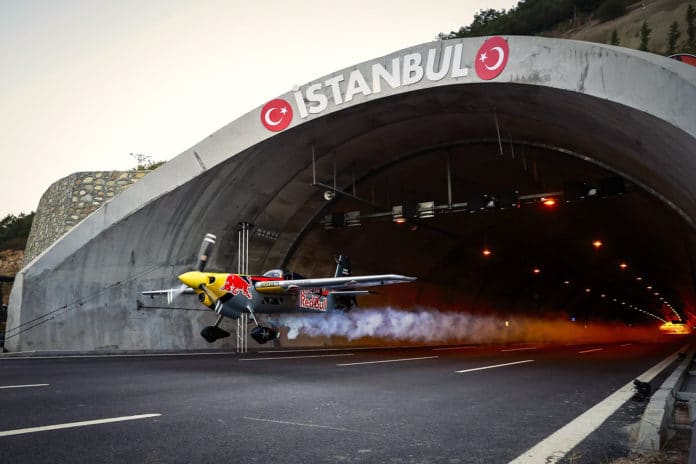While some pilots focus on flying high, but Dario Costa’s success in flying low has landed him in the Guinness Book of Records.
On Saturday, the Italian professional Red Bull Air Race and stunt pilot successfully maneuver his specially modified Zivko Edge 540 race plane through one of the dual Çatalca Tunnels on Turkey’s Northern Marmara Highway. In total, Costa set five world records after successfully completing a super-intense flight through two consecutive tunnels near Istanbul.
The Tunnel Pass flight was recognized with a Guinness World Record for Longest Tunnel Flown through with an Aeroplane (1,730m), and Costa was presented with the official certificate. The four other notable records were: first airplane flight through a tunnel, longest flight under a solid obstacle, first airplane flight through two tunnels, and first airplane takeoff from a tunnel. From takeoff to exiting the second tunnel, the flight covered a distance of 2.26 km at average speeds of 245 km/h, and the whole flight lasted for 43.44 seconds.
Costa and his mentor, aviation legend Péter Besenyei of Hungary, worked alongside 40 team members at Red Bull in order to pull off the flight. Everything from the time of day to the exact size of the wings was carefully planned.
On September 4, Costa took off in the dim light of the first tunnel at 6:43 am local time, with the early hour putting the sun at his back and offering optimal ambient conditions. The weight-reduced race plane was fitted with a Formula One seat, a human-made ‘sharkskin’ to reduce drag and improve efficiency and lift, and a laser measurement system for training.
“I’d never flown in a tunnel in my life – nobody had ever done it – so there was a big question mark in my head whether everything would go as we expected,” Costa said in a statement. “It was a big relief, of course, but big, big happiness was the main emotion. For me, it’s another dream come true.”
The airflow changes within the tunnels, and the highly sensitive steering of the aircraft required expertise in aerobatics. The pilot had to keep the plane on a stable flight path between 27 inches to five feet above the asphalt (70 cm to 1.6 meters) with 13 feet (four meters) between each wingtip and the unforgiving walls.
The most critical moment came when the plane flashed through the 360m gap between the tunnels, which exposed the lightweight aircraft to crosswinds as Costa prepared to thread it into the narrow opening of the second tunnel.
“Everything seemed to be happening so fast, but when I got out of the first tunnel, the plane started to move to the right because of the crosswinds, and in my head, everything slowed down at that moment,” explained Costa. “I reacted and just focused on getting the plane back on the right path to enter the other tunnel. Then in my mind, everything sped up all over again.“
